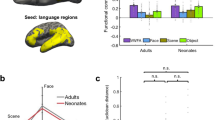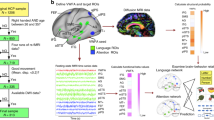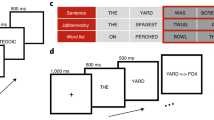Abstract
What determines the cortical location at which a given functionally specific region will arise in development? We tested the hypothesis that functionally specific regions develop in their characteristic locations because of pre-existing differences in the extrinsic connectivity of that region to the rest of the brain. We exploited the visual word form area (VWFA) as a test case, scanning children with diffusion and functional imaging at age 5, before they learned to read, and at age 8, after they learned to read. We found the VWFA developed functionally in this interval and that its location in a particular child at age 8 could be predicted from that child's connectivity fingerprints (but not functional responses) at age 5. These results suggest that early connectivity instructs the functional development of the VWFA, possibly reflecting a general mechanism of cortical development.
This is a preview of subscription content, access via your institution
Access options
Subscribe to this journal
Receive 12 print issues and online access
$209.00 per year
only $17.42 per issue
Buy this article
- Purchase on Springer Link
- Instant access to full article PDF
Prices may be subject to local taxes which are calculated during checkout





Similar content being viewed by others
References
Saygin, Z.M. et al. Anatomical connectivity patterns predict face selectivity in the fusiform gyrus. Nat. Neurosci. 15, 321–327 (2012).
Osher, D.E. et al. Structural connectivity fingerprints predict cortical selectivity for multiple visual categories across cortex. Cereb. Cortex 26, 1668–1683 (2015).
Mahon, B.Z. & Caramazza, A. What drives the organization of object knowledge in the brain? Trends Cogn. Sci. 15, 97–103 (2011).
Hannagan, T., Amedi, A., Cohen, L., Dehaene-Lambertz, G. & Dehaene, S. Origins of the specialization for letters and numbers in ventral occipitotemporal cortex. Trends Cogn. Sci. 19, 374–382 (2015).
Sur, M., Garraghty, P.E. & Roe, A.W. Experimentally induced visual projections into auditory thalamus and cortex. Science 242, 1437–1441 (1988).
Roe, A.W., Pallas, S.L., Hahm, J.O. & Sur, M. A map of visual space induced in primary auditory cortex. Science 250, 818–820 (1990).
Roe, A.W., Pallas, S.L., Kwon, Y.H. & Sur, M. Visual projections routed to the auditory pathway in ferrets: receptive fields of visual neurons in primary auditory cortex. J. Neurosci. 12, 3651–3664 (1992).
Sharma, J., Angelucci, A. & Sur, M. Induction of visual orientation modules in auditory cortex. Nature 404, 841–847 (2000).
Horng, S. et al. Differential gene expression in the developing lateral geniculate nucleus and medial geniculate nucleus reveals novel roles for Zic4 and Foxp2 in visual and auditory pathway development. J. Neurosci. 29, 13672–13683 (2009).
McCandliss, B.D., Cohen, L. & Dehaene, S. The visual word form area: expertise for reading in the fusiform gyrus. Trends Cogn. Sci. 7, 293–299 (2003).
Dehaene, S. et al. How learning to read changes the cortical networks for vision and language. Science 330, 1359–1364 (2010).
Glezer, L.S., Jiang, X. & Riesenhuber, M. Evidence for highly selective neuronal tuning to whole words in the “visual word form area”. Neuron 62, 199–204 (2009).
Glezer, L.S. & Riesenhuber, M. Individual variability in location impacts orthographic selectivity in the “visual word form area”. J. Neurosci. 33, 11221–11226 (2013).
Glezer, L.S., Kim, J., Rule, J., Jiang, X. & Riesenhuber, M. Adding words to the brain's visual dictionary: novel word learning selectively sharpens orthographic representations in the VWFA. J. Neurosci. 35, 4965–4972 (2015).
Baker, C.I. et al. Visual word processing and experiential origins of functional selectivity in human extrastriate cortex. Proc. Natl. Acad. Sci. USA 104, 9087–9092 (2007).
Srihasam, K., Vincent, J.L. & Livingstone, M.S. Novel domain formation reveals proto-architecture in inferotemporal cortex. Nat. Neurosci. 17, 1776–1783 (2014).
Grill-Spector, K., Kourtzi, Z. & Kanwisher, N. The lateral occipital complex and its role in object recognition. Vision Res. 41, 1409–1422 (2001).
Dehaene, S. & Cohen, L. Cultural recycling of cortical maps. Neuron 56, 384–398 (2007).
Dehaene, S. & Cohen, L. The unique role of the visual word form area in reading. Trends Cogn. Sci. 15, 254–262 (2011).
Haxby, J.V. et al. Distributed and overlapping representations of faces and objects in ventral temporal cortex. Science 293, 2425–2430 (2001).
Behrmann, M. & Plaut, D.C. Distributed circuits, not circumscribed centers, mediate visual recognition. Trends Cogn. Sci. 17, 210–219 (2013).
Tavor, I. et al. Task-free MRI predicts individual differences in brain activity during task performance. Science 352, 216–220 (2016).
Bouhali, F. et al. Anatomical connections of the visual word form area. J. Neurosci. 34, 15402–15414 (2014).
Yeatman, J.D., Rauschecker, A.M. & Wandell, B.A. Anatomy of the visual word form area: adjacent cortical circuits and long-range white matter connections. Brain Lang. 125, 146–155 (2013).
Cantlon, J.F., Pinel, P., Dehaene, S. & Pelphrey, K.A. Cortical representations of symbols, objects, and faces are pruned back during early childhood. Cereb. Cortex 21, 191–199 (2011).
Saygin, Z.M. et al. Tracking the roots of reading ability: white matter volume and integrity correlate with phonological awareness in prereading and early-reading kindergarten children. J. Neurosci. 33, 13251–13258 (2013).
Langer, N. et al. White matter alterations in infants at risk for developmental dyslexia. Cereb. Cortex http://dx.doi.org/10.1093/cercor/bhv281 (2015).
Brodmann, K. Vergleichende Lokalisationslehre der Grosshirnrinde in ihren Prinzipien dargestellt auf Grund des Zellenbaues (Barth, 1909).
Lorenz, S. et al. Two new cytoarchitectonic areas on the human mid-fusiform gyrus. Cereb. Cortex http://dx.doi.org/10.1093/cercor/bhv225 (2015).
Woodcock, R.W. Woodcock Reading Mastery Tests, Revised, Examiner's Manual (American Guidance Service, 1998).
Kaufman, A.S. & Kaufman, N.L. Kaufman Brief Intelligence Test (Wiley Online Library, 2004).
Dunn, D.M. & Dunn, L.M. Peabody Picture Vocabulary Test: Manual (Pearson, 2007).
van der Kouwe, A.J.W., Benner, T., Salat, D.H. & Fischl, B. Brain morphometry with multiecho MPRAGE. Neuroimage 40, 559–569 (2008).
Tisdall, M.D. et al. Volumetric navigators for prospective motion correction and selective reacquisition in neuroanatomical MRI. Magn. Reson. Med. 68, 389–399 (2012).
Dale, A.M., Fischl, B. & Sereno, M.I. Cortical surface-based analysis. I. Segmentation and surface reconstruction. Neuroimage 9, 179–194 (1999).
Fischl, B. et al. Whole brain segmentation: automated labeling of neuroanatomical structures in the human brain. Neuron 33, 341–355 (2002).
Fischl, B. et al. Automatically parcellating the human cerebral cortex. Cereb. Cortex 14, 11–22 (2004).
Desikan, R.S. et al. An automated labeling system for subdividing the human cerebral cortex on MRI scans into gyral based regions of interest. Neuroimage 31, 968–980 (2006).
Thesen, S., Heid, O., Mueller, E. & Schad, L.R. Prospective acquisition correction for head motion with image-based tracking for real-time fMRI. Magn. Reson. Med. 44, 457–465 (2000).
Gorgolewski, K. et al. Nipype: a flexible, lightweight and extensible neuroimaging data processing framework in python. Front. Neuroinform. 5, 13 (2011).
Fedorenko, E., Hsieh, P.-J., Nieto-Castañón, A., Whitfield-Gabrieli, S. & Kanwisher, N. New method for fMRI investigations of language: defining ROIs functionally in individual subjects. J. Neurophysiol. 104, 1177–1194 (2010).
Julian, J.B., Fedorenko, E., Webster, J. & Kanwisher, N. An algorithmic method for functionally defining regions of interest in the ventral visual pathway. Neuroimage 60, 2357–2364 (2012).
Postelnicu, G., Zollei, L. & Fischl, B. Combined volumetric and surface registration. IEEE Trans. Med. Imaging 28, 508–522 (2009).
Zöllei, L., Stevens, A., Huber, K., Kakunoori, S. & Fischl, B. Improved tractography alignment using combined volumetric and surface registration. Neuroimage 51, 206–213 (2010).
Yendiki, A. et al. Automated probabilistic reconstruction of white-matter pathways in health and disease using an atlas of the underlying anatomy. Front. Neuroinform. 5, 23 (2011).
Wang, H. & Yushkevich, P.A. Multi-atlas segmentation with joint label fusion and corrective learning—an open source implementation. Front. Neuroinform. 7, 27 (2013).
Menze, B.H. et al. The Multimodal Brain Tumor Image Segmentation Benchmark (BRATS). IEEE Trans. Med. Imaging 34, 1993–2024 (2015).
Tustison, N.J. et al. Large-scale evaluation of ANTs and FreeSurfer cortical thickness measurements. Neuroimage 99, 166–179 (2014).
Avants, B.B. et al. The Insight ToolKit image registration framework. Front. Neuroinform. 8, 44 (2014).
Jain, V. et al. Longitudinal reproducibility and accuracy of pseudo-continuous arterial spin-labeled perfusion MR imaging in typically developing children. Radiology 263, 527–536 (2012).
Lawson, G.M., Duda, J.T., Avants, B.B., Wu, J. & Farah, M.J. Associations between children's socioeconomic status and prefrontal cortical thickness. Dev. Sci. 16, 641–652 (2013).
Pineda, R.G. et al. Alterations in brain structure and neurodevelopmental outcome in preterm infants hospitalized in different neonatal intensive care unit environments. J. Pediatr. 164, 52–60 (2014).
Reuter, M., Rosas, H.D. & Fischl, B. Highly accurate inverse consistent registration: a robust approach. Neuroimage 53, 1181–1196 (2010).
Reuter, M. & Fischl, B. Avoiding asymmetry-induced bias in longitudinal image processing. Neuroimage 57, 19–21 (2011).
Reuter, M., Schmansky, N.J., Rosas, H.D. & Fischl, B. Within-subject template estimation for unbiased longitudinal image analysis. Neuroimage 61, 1402–1418 (2012).
Behrens, T.E.J., Berg, H.J., Jbabdi, S., Rushworth, M.F.S. & Woolrich, M.W. Probabilistic diffusion tractography with multiple fibre orientations: What can we gain? Neuroimage 34, 144–155 (2007).
Greve, D.N. & Fischl, B. Accurate and robust brain image alignment using boundary-based registration. Neuroimage 48, 63–72 (2009).
Hastie, T., Tibshirani, R. & Friedman, J. The Elements of Statistical Learning: Data Mining, Inference, and Prediction (Springer, 2009).
Huth, A.G., de Heer, W.A., Griffiths, T.L., Theunissen, F.E. & Gallant, J.L. Natural speech reveals the semantic maps that tile human cerebral cortex. Nature 532, 453–458 (2016).
Finn, A.S., Sheridan, M.A., Kam, C.L.H., Hinshaw, S. & D'Esposito, M. Longitudinal evidence for functional specialization of the neural circuit supporting working memory in the human brain. J. Neurosci. 30, 11062–11067 (2010).
Acknowledgements
We thank B. Fischl and M. Reuter for their guidance and advice on longitudinal registration, S. Robinson and O. Ozernov-Palchik for assistance with participant coordination and A. Park for technical assistance. We thank the Athinoula A. Martinos Imaging Center at the McGovern Institute for Brain Research at the Massachusetts Institute of Technology and its staff. We also thank our READ Study research testers, school coordinators and principals, and participating families. This work was funded by NICHD/NIH grant F32HD079169 to Z.M.S., NIH/NICHD R01HD067312 to J.D.E.G. and N.G., Ellison Medical Foundation, EY13455 to N.K., and grant 1444913 from McGovern Institute for Brain Research MINT to N.K. and Z.M.S.
Author information
Authors and Affiliations
Contributions
Z.M.S., D.E.O. and N.K. designed the experiments. Z.M.S., E.S.N., D.A.Y., S.D.B., N.G., J.D.E.G. and N.K. conducted the experiments or supplied data. Z.M.S., D.E.O., D.A.Y. and J.F. analyzed the data. Z.M.S., D.E.O. and N.K. wrote the manuscript.
Corresponding author
Ethics declarations
Competing interests
The authors declare no competing financial interests.
Integrated supplementary information
Supplementary Figure 1 fMRI experiment on 8 year olds.
(a) At age 8, children were shown words, scrambled words, line-drawings of objects, and line-drawings of faces over 6 experimental runs in a blocked design. A grid was overlaid on top of the stimuli so that all stimulus types (not just scrambled words) had edges. Each stimulus was presented for 500ms (ISI=0.193s) and overlaid on a different single-color background. Each run consisted of 18 blocks (4 blocks per stimulus type and 3 fixation blocks per run), and participants performed a one-back task. (b) fROIs were defined in each individual by intersecting that individual’s relevant thresholded activation contrast map with the relevant constraint region (e.g. for the VWFA, words > line-drawings of objects within VWFA constraint region). Constraint regions were defined from fMRI data in a separate group of adult participants as parcels within which most subjects had a significant activation, and were registered to each child’s native anatomy. Constraint regions for the VWFA (magenta), lFFA (yellow), and lPFS (cyan) are shown on an example subject’s inflated cortical surface. Note that while constraint regions are large (to accommodate individual variation) and overlap, the resulting fROIs within an individual are small and do not overlap.
Supplementary Figure 2 Percent signal change (PSC) for each fROI and age in pre-readers and readers.
(a) Example stimuli used for the age 5 fMRI experiment. The fMRI experiments at age 5 and age 8 were slightly different e.g. used different scanning protocols and different stimuli. To test whether the age 5 fMRI experiment could detect orthographic selectivity when it is present at age 5, we analyzed another cohort of children who could already read at age 5 (“readers”, right). We performed the same fROI percent signal change analysis that we did for the main cohort of children who could not read at age 5, defining fROIs on the age-8 data and measuring response magnitudes in those fROIs in independent data. (b) Percent signal change in VWFA, lFFA, and lPFS at age 8 (bottom) and age 5 (top) for children who could not read at age 5 (“pre- readers”, left; note that this is the same data as Figure 1 but is included here for comparison to the readers). (c) Percent signal change analysis in the children who could read (“readers") at both age 5 (top) and age 8 (bottom). Like the pre-readers (b), we find clear selectivity for faces in lFFA (F3,21 = 23.52, P = 6.49 x10-7; faces vs. words: P = 2.51 x 10-4; T = 6.81; faces vs. objects: P = 4.77 x 10-5; T = 8.85; faces vs. scrambled words: P = 7.41 x 10-4; T = 5.69) and clear selectivity for words in the VWFA for readers at age 8 (repeated measures ANOVA by condition: F3,21 = 5.92, P = 4.33 x10-3; words vs. objects: P = 2.01 x 10-3; T = 4.78; vs. faces: P = 2.99 x 10-2; T = 2.72; vs. scrambled words: P = 9.82 x 10-3; T = 3.51). However, while pre-readers do not show selectivity to letters in the VWFA at age 5, the readers do show selectivity to letters (bottom bar plots in b and c; repeated measures ANOVA by condition: F2,14 = 4.59, P = 2.93 x10-2; letters vs. faces: P = 3.48 x 10-2; T = 2.61; vs. false fonts: P = 2.07 x 10-2; T = 2.97). The lFFA also showed strong selectivity to faces over letters or false fonts at age 5 (F2,14 = 33.51, P = 4.60 x10-6; faces vs. letters: P = 1.14 x 10-4; T = 7.73; vs. false fonts: P = 8.66 x 10-4; T = 5.54. The response profile of the VWFA was distinct from both the lFFA (fROI x condition repeated measure ANOVA: F2,28 = 21.13, P = 2.55 x10-6) and from the lPFS at age 5 (F2,28 = 9.78, P = 6.01 x10-4) as well as at age 8 (VWFA vs. lFFA same three conditions as age 5, i.e. no objects condition: F2,28 = 18.30, P = 8.26 x10-6 and VWFA vs. lPFS: F2,28 = 5.93, P = 7.12 x10-3). Error bars = SE and horizontal bars reflect individual posthoc tests significant at P < 0.05.
Supplementary Figure 3 Percent signal change in the VWFA as a function of fROI volume in pre-readers and readers.
(a) Children who were not able to read at age 5 (“pre-readers”) did not show selectivity for letters as compared to faces or false fonts (top; for 5th percentile: letters vs. false fonts: P = 0.126; T(13) = 1.63; letters vs. faces: P = 0.711; T(13) = -0.379). We also defined percentiles in exactly the same way from age 8 data (bottom), and found strong selectivity for words (words vs. scrambled words: P = 3.02 x10-2; T(13) = 2.43; words vs. faces: P = 1.38 x10-2; T(13) = 4.05). Note that (a) is the same figure as Figure 2 in main text but also included here for comparison to children who could already read at age 5 (“readers”). (b) Readers do show selectivity for letters as compared to faces or false fonts, even in the most selective bin (top 5%) at age 5 (top; letters vs. false fonts: P = 1.79x10-2; T(7) = 3.08; letters vs. faces: P = 2.04 x 10-3; T(7) = 4.77) as well as at age 8 (bottom; words vs. scrambled words: P = 2.65 x10-2; (t7) = 2.80; words vs. faces: P = 2.19 x10-2; T(7) = 2.93). Error bars = SE.
Supplementary Figure 4 MVPA accuracy on age 5 fMRI data for all voxels within the VWFA parcel.
In children who could not yet read (left), classification accuracy was at chance for discriminating letters (from faces or false fonts; P = 0.30; T(13) = 1.07). In contrast, classification performance was significantly above chance for letters in children who could already read at age 5 (P = 3.10 x10-2; T(7) = 2.70). The region that will later become the VWFA cannot discriminate letters from faces or false fonts before these children can read. Thick lines reflect mean, thin lines reflect SE. Dotted line is chance accuracy.
Supplementary Figure 5 Group average (random effects) map for words > objects for leave-one-subject-out analysis on template brain.
Although the VWFA usually falls within the lateral surface of the occipitotemporal cortex, its precise location varies substantially across individuals13. Thus the group average maps of word-selectivity do not show above threshold activations as illustrated here. Colorbar scale indicates -log(p) values.
Supplementary information
Supplementary Text and Figures
Supplementary Figures 1–5 and Supplementary Tables 1–3 (PDF 1085 kb)
Supplementary Methods Checklist
(PDF 551 kb)
Rights and permissions
About this article
Cite this article
Saygin, Z., Osher, D., Norton, E. et al. Connectivity precedes function in the development of the visual word form area. Nat Neurosci 19, 1250–1255 (2016). https://doi.org/10.1038/nn.4354
Received:
Accepted:
Published:
Issue Date:
DOI: https://doi.org/10.1038/nn.4354
This article is cited by
-
Development of visual object recognition
Nature Reviews Psychology (2023)
-
Functional connectivity of the human face network exhibits right hemispheric lateralization from infancy to adulthood
Scientific Reports (2023)
-
Associations between digital media use and brain surface structural measures in preschool-aged children
Scientific Reports (2022)
-
Graph theoretical analysis reveals the functional role of the left ventral occipito-temporal cortex in speech processing
Scientific Reports (2022)
-
Medial prefrontal and occipito-temporal activity at encoding determines enhanced recognition of threatening faces after 1.5 years
Brain Structure and Function (2022)



